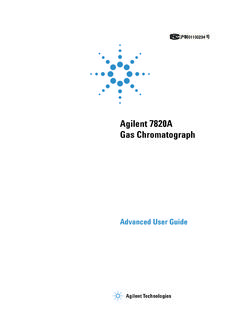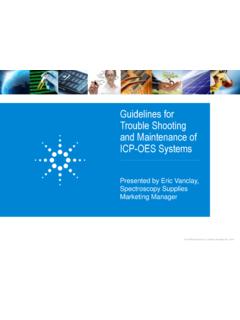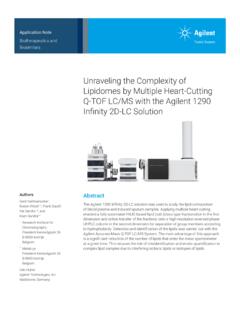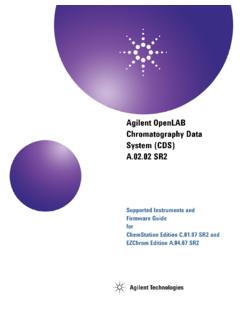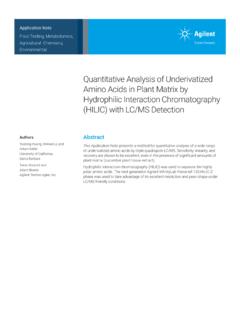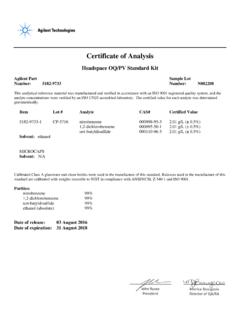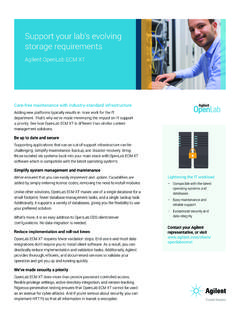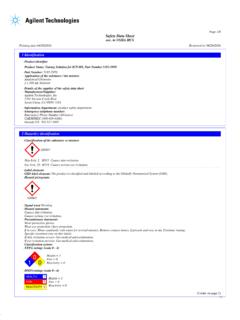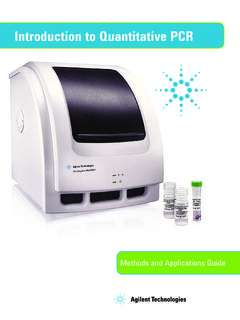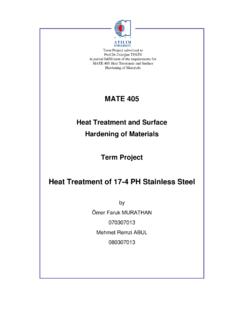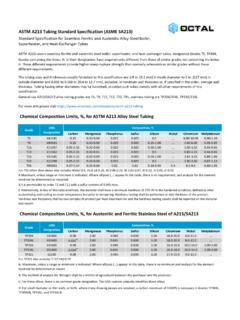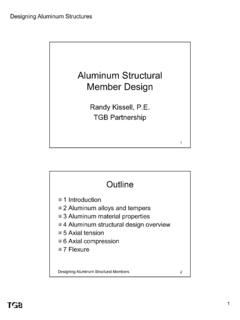Transcription of Flame Atomic Absorption Spectrometry - Agilent
1 Flame Atomic Absorption Spectrometry Analytical Methods 2 Flame Atomic Absorption Spectrometry Analytical Methods Notices Agilent Technologies, Inc. 1989, 1991, 1994, 1999, 2000, 2004, 2007, 2010-2013, 2015, 2017 No part of this manual may be reproduced in any form or by any means (including electronic storage and retrieval or translation into a foreign language) without prior agreement and written consent from Agilent Technologies, Inc. as governed by United States and international copyright laws. Manual Part Number 8510000900 Edition Fourteenth edition, May 2017 Agilent Technologies Australia (M) Pty, Ltd. 679 Springvale Road Mulgrave, Victoria, Australia 3199 Safety Notices A CAUTION notice denotes a hazard. It calls attention to an operating procedure, practice, or the like that, if not correctly performed or adhered to, could result in damage to the product or loss of important data.
2 Do not proceed beyond a CAUTION notice until the indicated conditions are fully understood and met. A WARNING notice denotes a hazard. It calls attention to an operating procedure, practice, or the like that, if not correctly performed or adhered to, could result in personal injury or death. Do not proceed beyond a WARNING notice until the indicated conditions are fully understood and met. CAUTION WARNING Flame Atomic Absorption Spectrometry Analytical Methods 3 Important Warning WARNING Eye, Explosion and Hearing Hazard Aspiration of perchloric acid and perchlorates into a nitrous oxide-acetylene Flame can create an explosion hazard, which can result in death or serious personal injury including temporary or permanent impairment of hearing. Do not use perchloric acid unless it is absolutely essential for sample preparation.
3 If perchloric acid must be used, it may be possible to reduce the risk of an explosion by taking the following measures: Use an air-acetylene Flame instead of a nitrous oxide-acetylene Flame . Reduce the concentrations of perchloric acid and metal in all analytical solutions to the lowest practical level. The concentration of perchloric acid should be reduced in the digestion stage and further reduced by extending the fuming stage. Aspirate all solutions for the shortest practical period. Always aspirate distilled water between samples. Minimize the aspiration of air. Use separate spray chamber/liquid trap assemblies for perchloric acid analyses and organic solvent analyses to prevent perchloric acid from mixing with organic solvent residues. NOTE When solvent extractions of perchloric acid solution are performed, some of the acid may dissolve in the organic solvent that is subsequently aspirated.
4 In addition, if the organic solution is aspirated whilst floating on the surface of the acid, do not allow the capillary tube to drop below the organic solvent and suck up aqueous perchloric acid. Clean the burner frequently never allow the burner to clog, and wash it thoroughly both inside and out. Minimize the amount of acetone which is carried over with the acetylene by: Cracking the bottle before use by gently opening the valve to check for any drops or spray of acetone. Any bottle showing acetone should be returned to the supplier for replacement. Storing and using the bottles in the vertical position. Using only one instrument per bottle. Using only instrument grade acetylene. Replacing bottles when the pressure drops to 750 kPa (100 psi). Ensure that all safety covers are in position, and wear approved ear protectors and safety glasses.
5 Ensure the pressure relief bung of the spray chamber can be easily removed by hand. Refit the bung according to the operation manual. 4 Flame Atomic Absorption Spectrometry Analytical Methods This page is intentionally left blank. Contents Flame Atomic Absorption Spectrometry Analytical Methods 5 Contents 1. Introduction 11 General 11 Safety Aspects 11 Reagents and Apparatus 12 Sample Preparation 12 Standard Preparation12 Automation 13 Matrix Effects 13 precipitation 13 Physical Properties of Standard and Sample 13 Chemical Interferences 13 Incomplete Dissociation of Compounds 13 Ionization 14 Nebulizers 15 Organic Solvents 15 Adjustable Nebulizer 15 Spray Chamber 15 Recommended Instrument Parameters 15 Working Conditions (Fixed) 15 Working Conditions (Variable) 15 General References 16 2.
6 Standard Conditions 17 Ag (Silver) 17 Recommended Instrument Parameters 17 Interferences 17 al (Aluminium) 17 Recommended Instrument Parameters 17 Interferences 18 References 18 As (Arsenic) 18 Recommended Instrument Parameters 18 Interferences 19 References 19 Au (Gold) 19 Recommended Instrument Parameters 19 Interferences 19 B (Boron) 20 Recommended Instrument Parameters 20 Interferences 20 Ba (Barium) 20 Recommended Instrument Parameters 20 Interferences 21 Be (Beryllium) 21 Recommended Instrument Parameters 21 Interferences 21 References 21 Bi (Bismuth) 21 Recommended Instrument Parameters 21 Interferences 22 Vapor Generation Method 22 References 22 Ca (Calcium) 22 Recommended Instrument Parameters 22 Interferences 22 References 23 Cd (Cadmium) 23 Contents 6 Flame Atomic Absorption Spectrometry Analytical Methods Recommended Instrument Parameters 23 Interferences 23 Co (Cobalt) 23 Recommended Instrument Parameters 23 Interferences 24 References 24 Cr (Chromium) 24 Recommended Instrument Parameters 24 Interferences 24 References 25 Cs (Cesium) 25 Recommended Instrument Parameters 25 Interferences 25 Cu (Copper)
7 25 Recommended Instrument Parameters 25 Interferences 26 Dy (Dysprosium) 26 Recommended Instrument Parameters 26 Interferences 26 References 26 Er (Erbium) 27 Recommended Instrument Parameters 27 Interferences 27 References 27 Eu (Europium) 27 Recommended Instrument Parameters 27 Interferences 28 References 28 Fe (Iron) 28 Recommended Instrument Parameters 28 Interferences 28 References 28 Ga (Gallium) 29 Recommended Instrument Parameters 29 Interferences 29 Gd (Gadolinium) 29 Recommended Instrument Parameters 29 Interferences 30 Ge (Germanium) 30 Recommended Instrument Parameters 30 Interferences 30 Hf (Hafnium) 30 Recommended Instrument Parameters 30 Interferences 31 Hg (Mercury) 31 Recommended Instrument Parameters 31 Interferences 31 References 31 Ho (Holmium) 32 Recommended Instrument Parameters 32 Interferences 32 In (Indium) 32 Recommended Instrument Parameters 32 Interferences 32 Ir (Iridium) 33 Recommended Instrument Parameters 33 Interferences 33 References 33 K (Potassium) 34 Recommended Instrument Parameters 34 Interferences 34 Contents Flame Atomic Absorption Spectrometry Analytical Methods 7 La (Lanthanum)
8 34 Recommended Instrument Parameters 34 Interferences 35 Li (Lithium) 35 Recommended Instrument Parameters 35 Interferences 35 Lu (Lutetium) 35 Recommended Instrument Parameters 35 Interferences 36 References 36 Mg (Magnesium) 36 Recommended Instrument Parameters 36 Interferences 36 References 37 Mn (Manganese) 37 Interferences 37 Mo (Molybdenum) 37 Recommended Instrument Parameters 37 Interferences 38 References 38 Na (Sodium) 38 Recommended Instrument Parameters 38 Interferences 38 Nb (Niobium) 38 Recommended Instrument Parameters 38 Interferences 39 References 39 Nd (Neodymium) 39 Recommended Instrument Parameters 39 Interferences 39 Ni (Nickel) 40 Recommended Instrument Parameters 40 Interferences 40 Os (Osmium) 40 Recommended Instrument Parameters 40 P (Phosphorus) 41 Recommended Instrument Parameters 41 Interferences 41 References 41 Pb (Lead) 41 Recommended Instrument Parameters 41 Interferences 42 Pd (Palladium) 42 Recommended Instrument Parameters 42 Interferences 42 References 42 Pr (Praseodymium)
9 42 Recommended Instrument Parameters 42 Interferences 43 Pt (Platinum) 43 Recommended Instrument Parameters 43 Interferences 43 References 44 Rb (Rubidium) 44 Recommended Instrument Parameters 44 Interferences 44 Re (Rhenium) 44 Recommended Instrument Parameters 44 Interferences 45 Rh (Rhodium) 45 Contents 8 Flame Atomic Absorption Spectrometry Analytical Methods Recommended Instrument Parameters 45 Interferences 45 References 45 Ru (Ruthenium) 46 Recommended Instrument Parameters 46 Interferences 46 References 46 Sb (Antimony) 46 Recommended Instrument Parameters 46 Interferences 47 Vapor Generation Method 47 References 47 Sc (Scandium) 47 Recommended Instrument Parameters 47 Interferences 47 References 48 Se (Selenium) 48 Recommended Instrument Parameters 48 Interferences 48 References 48 Si (Silicon) 48 Recommended Instrument Parameters 48 Interferences 49 Sm (Samarium) 49 Recommended Instrument Parameters 49 Interferences 49 Sn (Tin) 49 Recommended Instrument Parameters 49 Interferences 50 References 50 Sr (Strontium)
10 50 Recommended Instrument Parameters 50 Interferences 50 References 50 Ta (Tantalum) 51 Recommended Instrument Parameters 51 Interferences 51 References 51 Tb (Terbium) 51 Recommended Instrument Parameters 51 Interferences 52 Te (Tellurium) 52 Recommended Instrument Parameters 52 Interferences 52 Vapor Generation Method 52 References 52 Ti (Titanium) 53 Recommended Instrument Parameters 53 Interferences 53 References 53 Tl (Thallium) 53 Recommended Instrument Parameters 53 Interferences 53 Tm (Thulium) 54 Recommended Instrument Parameters 54 Interferences 54 V (Vanadium) 54 Recommended Instrument Parameters 54 Interferences 55 References 55 W (Tungsten) 55 Contents Flame Atomic Absorption Spectrometry Analytical Methods 9 Recommended Instrument Parameters 55 Interferences 55 References 55 Y (Yttrium) 56 Recommended Instrument Parameters 56 Interferences 56 Yb (Ytterbium) 56 Recommended Instrument Parameters 56 Interferences 56 Zn (Zinc) 57 Recommended Instrument Parameters 57 Interferences 57 Zr (Zirconium) 57 Recommended Instrument Parameters 57 Interferences 58 Ref
